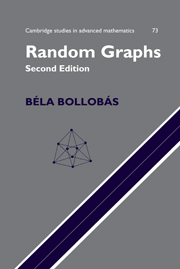Book contents
- Frontmatter
- Contents
- Preface to the Second Edition
- Preface
- Notation
- 1 Probability Theoretic Preliminaries
- 2 Models of Random Graphs
- 3 The Degree Sequence
- 4 Small Subgraphs
- 5 The Evolution of Random Graphs—Sparse Components
- 6 The Evolution of Random Graphs—the Giant Component
- 7 Connectivity and Matchings
- 8 Long Paths and Cycles
- 9 The Automorphism Group
- 10 The Diameter
- 11 Cliques, Independent Sets and Colouring
- 12 Ramsey Theory
- 13 Explicit Constructions
- 14 Sequences, Matrices and Permutations
- 15 Sorting Algorithms
- 16 Random Graphs of Small Order
- References
- Index
16 - Random Graphs of Small Order
Published online by Cambridge University Press: 29 March 2011
- Frontmatter
- Contents
- Preface to the Second Edition
- Preface
- Notation
- 1 Probability Theoretic Preliminaries
- 2 Models of Random Graphs
- 3 The Degree Sequence
- 4 Small Subgraphs
- 5 The Evolution of Random Graphs—Sparse Components
- 6 The Evolution of Random Graphs—the Giant Component
- 7 Connectivity and Matchings
- 8 Long Paths and Cycles
- 9 The Automorphism Group
- 10 The Diameter
- 11 Cliques, Independent Sets and Colouring
- 12 Ramsey Theory
- 13 Explicit Constructions
- 14 Sequences, Matrices and Permutations
- 15 Sorting Algorithms
- 16 Random Graphs of Small Order
- References
- Index
Summary
Most of the results in the previous chapters concern spaces of random graphs of order n as n → ∞: even our inequalities were claimed to hold only ‘if n is sufficiently large’. Nevertheless, asymptotic results are often applied for rather small values of n, so the question arises as to how good these approximations are when n is not too large. The main aim of this chapter is to reproduce some of the tables concerning graphs of fairly small order, given by Bollobás and Thomason (1985). These tables are still far beyond the bound for which exact calculations are possible; for exact tables concerning graphs of small order (mostly general graphs of order at most 14 and trees of order at most 27), the reader should consult, among others, Bussemaker et al. (1976), Quintas, Stehlik and Yarmish (1979), Quintas, Schiano and Yarmish (1980), Brown et al. (1981) and Halberstam and Quintas (1982, 1984). For the use of information about small subgraphs see, among others, Frank and Frisch (1971), Frank (1977, 1979a, b), Frank and Harary (1980a, b), Gordon and Leonis (1976) and Quintas and Yarmish (1981).
Connectivity
We know from Theorem 7.3 that if c ∈ ℝ is a constant, p =(log + c)/n and M = ⌊(n/2)(log n + c)⌋, then limn→∞P(Gp is connected) = limn→∞P(GM is connected) = 1 − e−e−c.
- Type
- Chapter
- Information
- Random Graphs , pp. 447 - 456Publisher: Cambridge University PressPrint publication year: 2001



